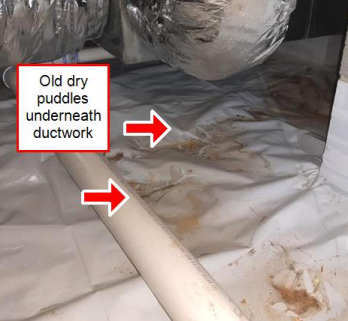The 5 Most Costly Home Repairs That Are Easy To Avoid
When helping people buy and sell real estate there is always something new or more to learn, which is one of the many reasons I love my job. Every home buying and selling experience is unique, and no two days are the same. Over the years clients have often said, “I had no idea this was part of your job,” or “Oh, I thought you just showed homes all day.” These comments were often made when I was doing things like crawling under a home or watching a septic tank be pumped.
I’ve learned a lot from the home inspectors and other professionals I’ve worked with over the years and I aim to use this knowledge to improve my clients’ real estate experience, and ultimately save them money. I’ve encountered many situations where an individual has had to spend thousands upon thousands of dollars to repair a home due to lack of home maintenance or attention. More times than not costly repairs could have been prevented if the homeowner had taken the time to peek in their crawl space or walked around the exterior of their home and made note of the items that needed attention. A small investment of time, energy and attention can save a homeowner money and headaches.
Costly Repairs When Selling Your Home
When homeowners decide to sell their home they often spend a considerable amount of money on things like fresh paint and landscaping but they don’t always think about less obvious areas, like their crawl space. An interested buyer might not pay attention to the crawl space either, but in North Carolina, almost all buyers hire a home inspector to inspect the home they’re purchasing. A good inspector will most certainly spend a fair amount of time going over all areas of the home from the attic to the crawl space and this is when issues are often discovered. I’ve spent my fair share of time tagging along with home inspectors at my clients’ inspections and I’ve helped both buyers and sellers negotiate costly repairs. A home can have great curb appeal and go under contract the first day it hits the market but if major issues are uncovered during the inspection, a seller can end up having to spend significant money they hadn’t budgeted for.
So what are the most costly repairs that leave some homeowners in tears? Check out the list below to make sure you’re in tune with your home and doing the regular maintenance that will ultimately save you money.
1. Siding, Trim and Decks
At least twice a year take a stroll around your home and make note of any siding or trim that shows signs of peeling paint or water damage. If you see siding with cracks or nail pops, address the issue immediately. When water gets between pieces of siding or trim you end up with rot and the wood continues to break down if not repaired properly. Pay extra attention to trim around doors, windows and gutters.
2. Foundation and Crawl Space
I’ve worked with so many homeowners who could have saved themselves thousands of dollars if they had opened their crawl space door and taken a peek inside twice a year. I know it’s dark and your imagination can play awful tricks on you when crawling around down there but I promise you, it’s worth it. If you don’t want to do it, hire a professional to come out and take a look around.
Crawl spaces alone are not cause for concern, but it’s when water makes its way into the crawl space that we end up with issues. As a homeowner, you should be aware of how water moves through your yard. Where does it puddle? Does one side of your yard slope toward your home resulting in water running toward your foundation during heavy rains?
When water penetrates your foundation walls and enters your crawl space it can result in high moisture levels, which leads to fungal growth on the floor framing and the foundation walls. Cleaning the fungal growth alone can be costly but when high levels of moisture exist in a crawl space for extended periods of time it can result in significant structural damage to the home. If you want to monitor the humidity level in your crawl space, as it can vary greatly depending on the season, you might consider purchasing a relatively inexpensive humidity monitor.
Below are pictures from clients’ home inspections that show the damage that can occur if poor water management or drainage occurs for extended periods of time. If the homeowners had checked their crawl space or hired a professional to do so, it’s very likely the issues would have been discovered before such extensive and costly damage occurred.
How do you know if you have a reason for concern or if you need to call a professional?
Standing water or signs of dried puddles
Hanging insulation
Efflorescence on the foundation walls
Fungal growth
In the situations shown above, all of the homeowners had to pay for expensive mold remediation in addition to thousands of dollars in structural repairs.
3. Septic Systems
If your property has a septic system it is very important to not only maintain the system but to also understand your septic layout as well. Make sure you know where the septic tank, septic field and septic repair area are located. Most septic professionals suggest pumping your tank every 3-5 years along with keeping saplings from growing in your drainfield. Some homeowners have their septic systems pumped and inspected when they purchase their home but they fail to think about it again until there is a problem. Minor issues like root intrusion from lack of maintenance can result in costly repairs if not addressed.
To learn more about septic systems, how they function and maintenance tips, I suggest checking out N.C. Cooperative Extension.
4. Windows
We’re learning that in today’s world fewer and fewer people are opening their windows on a regular basis. A lot of homeowners have no idea that their windows aren’t functioning properly or that they are in poor condition due to water intrusion. It’s rare that a home has just one window that is rotten and needs to be replaced, so if a home inspector finds one, there are often several others. I once worked with a homeowner who had a very demanding job that left her with little time to think about home maintenance. Although her house was only about 15 years old when she turned to sell it, the areas around the windows hadn’t been sealed and painted as often as needed, which resulted in significant rot to the window sashes. Ultimately, the seller had to pay almost $13,000 to replace damaged windows before selling the home.
5. Gutters
Clogged and misaligned gutters can lead to various problems such as rotten fascia and soffit boards and overall poor water management around your home. When gutters are filled with leaves and other debris they aren’t able to function as intended, which is to move water away from a home’s foundation. If you see wood trim around your gutters that is discolored or damaged, this is a sign that your gutters are either clogged or might need to be adjusted so that water can flow toward a downspout.
I suggest the next time it rains, grab an umbrella and head outside to see if your gutters are handling the water the way they should. Is water running over your gutters and dropping at the base of your home? Do you see standing water around your foundation? Do your downspouts dump water at the foundation or do they carry the water away from your home? Again, with a little attention and observation, you can save yourself lots of money down the road.
Planter boxes on your deck can function as mini gardens if space is limited.
We often put off work around our home with the intention of getting to it when a long weekend rolls around or when the weather warms up. Sometimes, the work is put off for several months, if not longer, and meanwhile the damage and cost only increase. Homeownership is often an individual’s largest investment and it is important to protect it. Services such as annual termite inspections and routine heating and air inspections are always a good idea. You can hire a home inspector to inspect your home and you should receive a thorough report with all of their findings and their suggestions about what items should be addressed immediately and those that you can keep an eye on over time. The National Association of Home Builders provides great information about routine maintenance for both the interior and exterior of your home.
And lastly, if you have questions about your home and you’re wondering who to call, reach out to your trusted real estate agent. Your agent should be someone that not only leads you through the home buying and selling process but should be able to point you in the right direction when you’re faced with maintenance and repair concerns.









